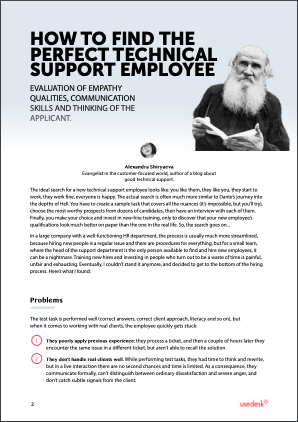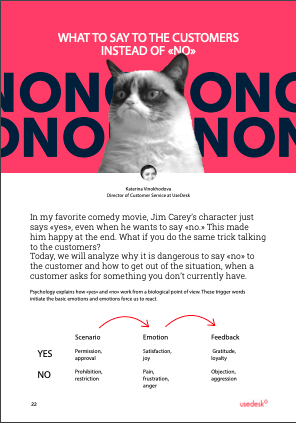Request a Demo
Send us a request for an online demonstration at the time that's convenient for you. We will give you an overview and answer any questions you may have about the system.
By clicking the button, you agree that you have read our Privacy Policy
WHAT TO SAY TO THE CUSTOMERS
INSTEAD OF "NO"

Katerina Vinokhodova
Director of Customer Service at Usedesk
In my favorite comedy movie, Jim Carey's character says "yes," even when he wants to say "no." This made him happy in the end. What if you do the same trick talking to the customers?
Today, we will analyze why it is dangerous to say "no" to the customer and get out of the situation when a customer asks for something you don't currently have.
Psychology explains how "yes" and "no" work from a biological point of view. These trigger words initiate the basic emotions, and emotions force us to react.
Today, we will analyze why it is dangerous to say "no" to the customer and get out of the situation when a customer asks for something you don't currently have.
Psychology explains how "yes" and "no" work from a biological point of view. These trigger words initiate the basic emotions, and emotions force us to react.
Ask any operator: the most enjoyable thing in his job is to say "yes" to the customer in response to his request and hear, "thank you, you helped me a lot!" However, when you cannot fulfill the customer's request, the refusal does not promise anything good.
Remember your childhood when your mother said "no" to your request to buy a toy.
You had two options:
Remember your childhood when your mother said "no" to your request to buy a toy.
You had two options:
- do not give up and ask father, hoping he will make another decision,
- fall down to the floor, scream and cry, wave arms and legs until "no" turns into a "yes."
What customer says
What a disrespect! What the hell are you doing there if you cannot help? No, I do not care how you will do it!
Connect me with your manager right now!
I cancel all my accounts! You've lost me as a client! Today, Facebook will know a lot about you!!!
What a disrespect! What the hell are you doing there if you cannot help? No, I do not care how you will do it!
Connect me with your manager right now!
I cancel all my accounts! You've lost me as a client! Today, Facebook will know a lot about you!!!
What's going on
The customer gets emotional quickly - he argues with the operator, curses, demonstrates aggression. If this does not help, he moves to the next strategy.
The option of "appealing to father" who has more power to solve the problem bypassing the rules. Another way: the customer hangs up and calls back later: "maybe, another operator will be more helpful".
He openly threatens to leave and spread negative information in the media and social networks. The last one is the worst, and this strategy is used by more advanced customers as a life-hack from the very beginning of the conversation, forcing the company to make exceptions.
The customer gets emotional quickly - he argues with the operator, curses, demonstrates aggression. If this does not help, he moves to the next strategy.
The option of "appealing to father" who has more power to solve the problem bypassing the rules. Another way: the customer hangs up and calls back later: "maybe, another operator will be more helpful".
He openly threatens to leave and spread negative information in the media and social networks. The last one is the worst, and this strategy is used by more advanced customers as a life-hack from the very beginning of the conversation, forcing the company to make exceptions.
That's what the word "no" means in a customer's mind:
NO = NO solution
NO = have to put in a lot of effort
The operators' task is the opposite:
Lead the customer to a solution.
Be ready for the negative reaction to "no."
Prevent it.
It sounds like magic, but you don't need magic here – just try a simple rule:
Instead of telling a customer what you cannot do, say what you can do.
Let's take a closer look into two techniques to help you use this rule in practice.
NO = NO solution
NO = have to put in a lot of effort
The operators' task is the opposite:
Lead the customer to a solution.
Be ready for the negative reaction to "no."
Prevent it.
It sounds like magic, but you don't need magic here – just try a simple rule:
Instead of telling a customer what you cannot do, say what you can do.
Let's take a closer look into two techniques to help you use this rule in practice.
1. Start using positive language
Listen to the recorded calls, read e-mails sent, and find out how many times and in what situations the operators said no. Track the customers' reactions. Write down the details of each conflict and make a chart of the most potentially dangerous situations. Now, bravely delete from the old templates designed for these situations these words: "no", "impossible", and a particle "not." Let's see how Osram Sylvania did all of that.
Conflict situations
Order of product
Placing an order
Price negotiation
Delivery failure or product damage
Notification of delay
Product return
Order of product
Placing an order
Price negotiation
Delivery failure or product damage
Notification of delay
Product return
No
We do not have this product in stock
We cannot ship the order until ...
You have to talk to the sales department about the price
We must arrange product replacement
You will not receive your order on time
You need to write the return number on the package
We do not have this product in stock
We cannot ship the order until ...
You have to talk to the sales department about the price
We must arrange product replacement
You will not receive your order on time
You need to write the return number on the package
Yes
The product you are interested in will be available for ordering ...
We can fulfill the order ...
You can discuss it with a sales representative
The best thing we can do in this situation ...
To receive the product on time, please send your order ...
Please make sure the return number is given on the package
The product you are interested in will be available for ordering ...
We can fulfill the order ...
You can discuss it with a sales representative
The best thing we can do in this situation ...
To receive the product on time, please send your order ...
Please make sure the return number is given on the package
After these rules were implemented, Osram Sylvania reduced the effort score by 18.5%, and the number of calls transferred to the "senior" members reduced by two times. Try it and see what your company can achieve through such language changes.
Hint: for written requests, centralize new templates in UseDesk so that the change is implemented flawlessly and agents do not repeat past mistakes.
Hint: for written requests, centralize new templates in UseDesk so that the change is implemented flawlessly and agents do not repeat past mistakes.
2. Find an alternative solution
We have learned how to replace "no" in theory, mitigating the customer's possible adverse reaction. However, this is only a cosmetic repair. In reality, if we do not offer an alternative solution that is suitable for the customer, a positive language will not help.
It seems clear, but there is only one way to help the customer solve the problem: find out what he needs. The mistake that the operators make quite often is taking the customer's request literally. However, what the customer says and the real pain he suffers can be very different. The purpose is to find the source of the pain and solve the problem that causes it. Therefore, dig deeper.
It seems clear, but there is only one way to help the customer solve the problem: find out what he needs. The mistake that the operators make quite often is taking the customer's request literally. However, what the customer says and the real pain he suffers can be very different. The purpose is to find the source of the pain and solve the problem that causes it. Therefore, dig deeper.
Ask questions
The customer asks to arrange delivery for tonight, but there are no free couriers. Do not rush to answer; instead, take a pause saying you need to verify the information. You won some time, now use these seconds strategically to learn the details of the customer's situation that will help you to find the right solution.
The customer asks to arrange delivery for tonight, but there are no free couriers. Do not rush to answer; instead, take a pause saying you need to verify the information. You won some time, now use these seconds strategically to learn the details of the customer's situation that will help you to find the right solution.
Bad:
– Sorry, we do not have couriers available in the evening! But you can visit our self-pickup location!
– Sorry, I'll have to order in another store.
– Sorry, we do not have couriers available in the evening! But you can visit our self-pickup location!
– Sorry, I'll have to order in another store.
Good:
– Let's see... You ordered a gift set of cosmetics, right? If it is not a secret, who is the gift for?
– For my sister, she has a birthday tomorrow, so I'm planning in advance.
– Great choice! Are you going to celebrate tomorrow?
– Yes!
– Looks like I found a courier available for tomorrow morning. It appears all couriers are busy tonight already, but tomorrow morning a courier will be able to deliver your order anywhere you would like - to work or home address. Thus, you will have the gift ready before dinner!
– Ok, sounds good!
– Let's see... You ordered a gift set of cosmetics, right? If it is not a secret, who is the gift for?
– For my sister, she has a birthday tomorrow, so I'm planning in advance.
– Great choice! Are you going to celebrate tomorrow?
– Yes!
– Looks like I found a courier available for tomorrow morning. It appears all couriers are busy tonight already, but tomorrow morning a courier will be able to deliver your order anywhere you would like - to work or home address. Thus, you will have the gift ready before dinner!
– Ok, sounds good!
Bad:
– I do not see any problems with the card; probably, the ATM is not working!
– But my friend just withdrew money from his card through that ATM!
– Sorry, I cannot help! It looks like the card chip is demagnetized; you need to get a new card.
– I do not see any problems with the card; probably, the ATM is not working!
– But my friend just withdrew money from his card through that ATM!
– Sorry, I cannot help! It looks like the card chip is demagnetized; you need to get a new card.
Good:
– Are there any people you know around?
– Yes, a friend who just withdrew money from his card.
– It's OK. We can transfer money from your account to a friend's account, and he will withdraw cash for you. The transfer is free, and the money will be on his account in a second.
– Really?? I did not know that it's free. Great, let's do that! Good!
– We will reissue your card and deliver it to you as soon as you return from vacation.
– Perfect!
– Are there any people you know around?
– Yes, a friend who just withdrew money from his card.
– It's OK. We can transfer money from your account to a friend's account, and he will withdraw cash for you. The transfer is free, and the money will be on his account in a second.
– Really?? I did not know that it's free. Great, let's do that! Good!
– We will reissue your card and deliver it to you as soon as you return from vacation.
– Perfect!
The more you know about the customer, the more likely you will be able to help.
– Oh, yeah, a customer always shares the details!
Not every customer is ready to chat with the operator, and not all problems have an alternative solution, but the result is worth trying.
The Canadian company LoyaltyOne conducted an internal study of this technique: a group of employees talked to customers asking additional questions and offering alternatives. The second group served customers in an old-fashioned way. The first group showed an excellent result:
So, remember three key points when choosing an alternative for the customer:
1. Do not rush to say NO.
2. Do not make excuses explaining why you cannot offer what the customer asks.
3. The customer may not know how to solve the problem better.
It's your job.
The highest proficiency is to find and offer an alternative solution even before you say "we cannot" to the customer. When writing the article, I used the book " The Effortless Experience: Conquering the New Battleground for Customer Loyalty" by Rick Delisi, Matthew Dickson, and Nick Thomas
The Canadian company LoyaltyOne conducted an internal study of this technique: a group of employees talked to customers asking additional questions and offering alternatives. The second group served customers in an old-fashioned way. The first group showed an excellent result:
- The customer care score is higher by 11%.
- The share of the problems solved since the first inquiry is 7% higher.
- The duration of the call has decreased.
So, remember three key points when choosing an alternative for the customer:
1. Do not rush to say NO.
2. Do not make excuses explaining why you cannot offer what the customer asks.
3. The customer may not know how to solve the problem better.
It's your job.
The highest proficiency is to find and offer an alternative solution even before you say "we cannot" to the customer. When writing the article, I used the book " The Effortless Experience: Conquering the New Battleground for Customer Loyalty" by Rick Delisi, Matthew Dickson, and Nick Thomas
When writing the article, I used the book " The Effortless Experience: Conquering the New Battleground for Customer Loyalty" by Rick Delisi, Matthew Dickson, and Nick Thomas
Share with your colleagues:
Did you like this article?
Error get alias
We know a lot about customer service
Once every two weeks, we will send exciting and valuable materials about customer service - articles, cases, and system updates. Do you mind?







